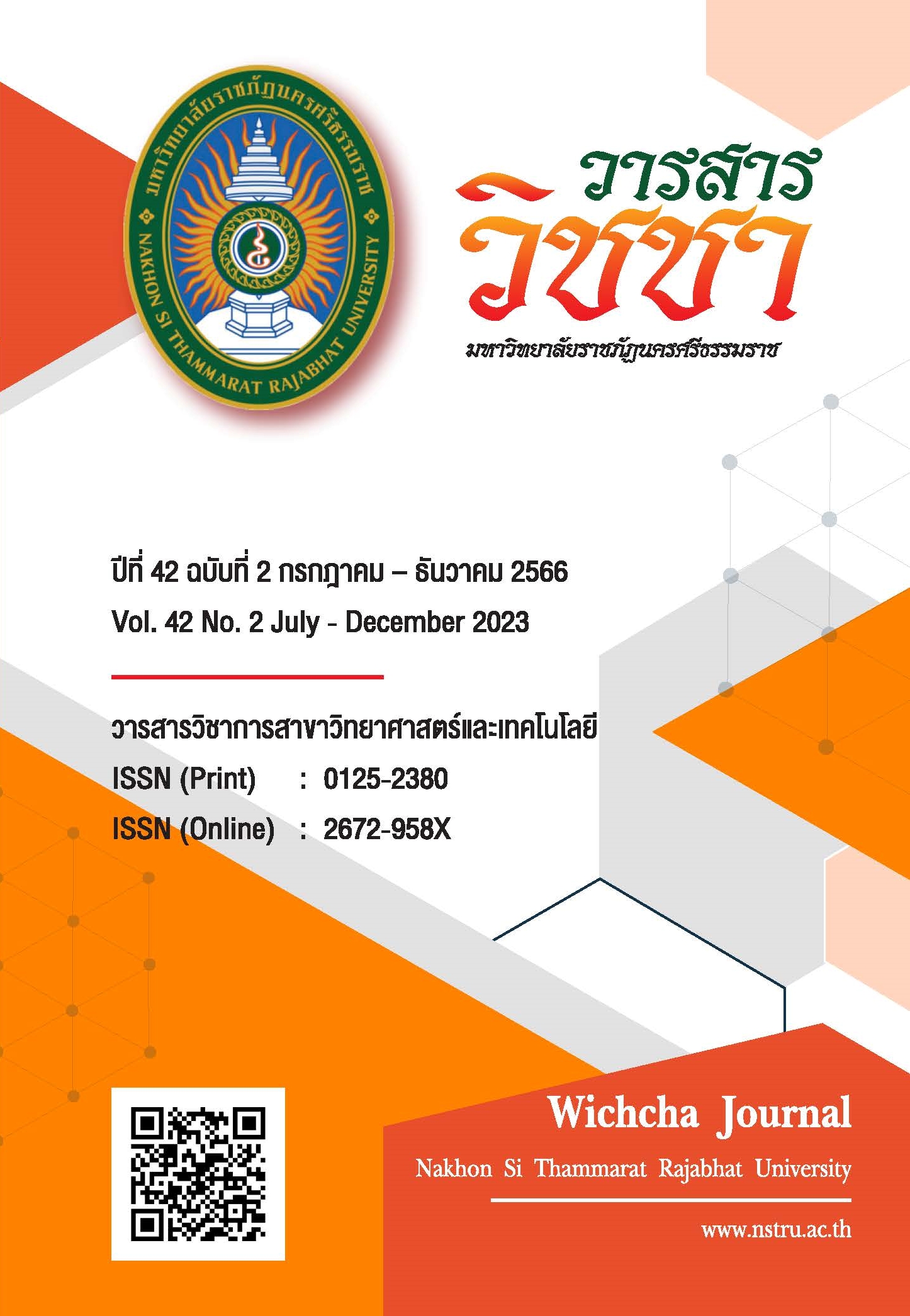Biogas Production from Co-Digestion of Pretreated Spent Grounds Coffee with Cow Dung (Manure) by Batch and Fed-Batch Fermentation
Main Article Content
Abstract
This research aimed to investigate the biogas production from co-digestion of pretreated spent ground coffee and cow manure in batch and fed-batch fermentation processes at 35°C. The ratio of pretreated coffee grounds to cow manure was 4:1 representing 10% of the total solids solid material. The experimental results of the batch fermentation process were showed that the carbon-to-nitrogen ratio (C:N ratio) of coffee grounds with cow manure at 24:1 has maximum biogas yield of 44.50 milligram per gram volatile solids (ml/g-VS). Therefore, this optimum C:N ratio (24:1) was used for biogas production in a semi-batch fermentation process. However, when adding organic substances to the system every 2 days, which was 3 times for 15 days, the maximum biogas content was Type 1 (the maximum accumulated biogas was 38.00 ml/g-VS) and the amount of methane and carbon dioxide were 20.12% and 6.47%.
Article Details

This work is licensed under a Creative Commons Attribution-NonCommercial-NoDerivatives 4.0 International License.
เนื้อหาและข้อมูลในบทความที่ลงตีพิมพ์ในวารสารวิชชา มหาวิทยาลัยราชภัฏนครศรีธรรมราช ถือเป็นข้อคิดเห็นและความรับผิดชอบของผู้เขียนบทความโดยตรง ซึ่งกองบรรณาธิการวารสารไม่จำเป็นต้องเห็นด้วยหรือร่วมรับผิดชอบใด ๆ
บทความ ข้อมูล เนื้อหา รูปภาพ ฯลฯ ที่ได้รับการตีพิมพ์ในวารสารวิชชา มหาวิทยาลัยราชภัฏนครศรีธรรมราช ถือเป็นลิขสิทธ์ของวารสารวิชชา มหาวิทยาลัยราชภัฏนครศรีธรรมราช หากบุคคลหรือหน่วยงานใดต้องการนำข้อมูลทั้งหมดหรือส่วนหนึ่งส่วนใดไปเผยแพร่ต่อหรือเพื่อการกระทำการใด ๆ จะต้องได้รับอนุญาตเป็นลายลักษณ์อักษรจากวารสารวิชชา มหาวิทยาลัยราชภัฏนครศรีธรรมราชก่อนเท่านั้น
The content and information in the article published in Wichcha journal Nakhon Si Thammarat Rajabhat University, It is the opinion and responsibility of the author of the article. The editorial journals do not need to agree. Or share any responsibility.
References
กรมพัฒนาพลังงานทดแทนและอนุรักษ์พลังงาน กระทรวงพลังงาน. (2561). คู่มือฝึกอบรมภาคปฏิบัติด้านพลังงานทดแทน การผลิตก๊าซชีวภาพจากวัตถุดิบต่าง ๆ. อุบลราชธานี: มหาวิทยาลัยอุบลราชธานี.
กิตติยา ป้อมเงิน ประภา โซ๊ะสลาม และรัชพล พะวงศ์รัตน์. (2559). การผลิตแก๊สชีวภาพจากผักตบชวาที่ผ่านการปรับสภาพด้วยการนึ่งร่วมกับมูลวัวโดยกระบวนการหมักแบบกะ. วารสารมหาวิทยาลัยนราธิวาสราชนครินทร์, 8(3), 129-139.
จุฑาภรณ์ ชนะถาวร และนาวิน พูดน้อย. (2560). การหมักร่วมของกากกาแฟและเปลือกเมล็ดกาแฟที่ผ่านการปรับสภาพร่วมกับมูลโคเพื่อเพิ่มประสิทธิภาพการผลิตก๊าซชีวภาพ. ใน การประชุมวิชาการเครือข่ายพลังงานแห่งประเทศไทย ครั้งที่ 13 (วิทยาลัยพลังงานทดแทน) (หน้า 112-119). เชียงใหม่: มหาวิทยาลัยแม่โจ้.
ณัฐพงศ์ ตันติวัฒนพันธ์. (2562). กากกาแฟ จากแก้วกาแฟสู่แนวคิดเศรษฐกิจหมุนเวียนสำหรับผลิตภัณฑ์ชีวภาพ. วารสารสิ่งแวดล้อม, 23(1), 1-8.
นฤภัทร ตั้งมั่นคงวรกูล และพัชรี ปรีดาสุริยะชัย. (2558). การศึกษากากกาแฟและกากชามาใช้ ประโยชน์ในรูปเชื้อเพลิงอัดแท่ง. วารสารมหาวิทยาลัยศรีนครินทรวิโรฒ, 7(13), 15-26.
นัฐวุฒิ เพ็ชรชาติ พิมพ์ชนก ธาตรีวิจิตร หนึ่งหทัย ธราพร ศราวุฒิ ชูโลก และนวรัตน์ สีตะพงษ์. (2566). สมบัติการเป็นเชื้อเพลิงของชีวมวลอัดแท่งและถ่านชีวมวลอัดแท่งจากเปลือกกระท้อนและเปลือกมังคุด. วารสารวิชชา มหาวิทยาลัยราชภัฏนครศรีธรรมราช, 42(1), 39-49.
มั่นสิน ตัณฑุลเวศม์. (2551). คู่มือวิเคราะห์คุณภาพน้ำ. (พิมพ์ครั้งที่ 5). กรุงเทพฯ: โรงพิมพ์แห่งจุฬาลงกรณ์มหาวิทยาลัย.
รพีพรรณ กองตมู. (2560). กากกาแฟ: มูลค่าเพิ่มและการใช้ประโยชน์. ใน การประชุมวิชาการระดับชาติ ครั้งที่ 5 (หน้า 342-350). ราชบุรี: มหาวิทยาลัยราชภัฏหมู่บ้านจอมบึง.
รัชพล พะวงศ์รัตน์. (2558). ศักยภาพและการใช้ประโยชน์จากวัสดุเศษเหลือทางการเกษตรประเภทลิกโนเซลลูโลสเพื่อผลิตแก๊สชีวภาพ. วารสารวิชาการปทุมวัน, 5(14), 67-78.
เวสารัช สุนทรชัยบรูณ์ ธัญวิทย์ พลายงาม และรัชพล พะวงศ์รัตน์. (2558). การปรับสภาพขุยมะพร้าวเพื่อผลิตแก๊สชีวภาพโดยกระบวนการหมักแบบไม่ใช้ออกซิเจนร่วมกับมูลวัว. วารสารวิชาการและวิจัย มหาวิทยาลัยเทคโนโลยีราชมงคลพระนคร, 9(2), 19-31.
สิริวรรณ ลี้ศิริสรรพ์. (2561). สมบัติของเส้นใยใบสับปะรดที่ผ่านการปรับสภาพด้วยวิธีทางเคมี. กรมวิทยาศาสตร์บริการ, 7(7), 25-31.
อรุณี ศุภสินสาธิต. (2555). พลังงานจากชีวมวลที่มีลิกโนเซลลูโลสสูง. วารสารสิ่งแวดล้อม, 17(2), 36-43.
อุตสาหกรรมฐานชีวภาพ. (2561). บทที่ 33 รายละเอียดข้อมูลสารเคมีชีวภาพประเภทลิกนิน (lignin). ใน รายงานการศึกษาฉบับสมบูรณ์ โครงการเพิ่มศักยภาพฐานข้อมูลพื้นฐานอุตสาหกรรมชีวภาพ (หน้า 1-16). กรุงเทพ: มหาวิทยาลัยเทคโนโลยีพระจอมเกล้าพระนครเหนือ.
Corro, G., Paniagua, L., Pal, U., Bañuelos, F. and Rosas, M. (2013). Generation of biogas from coffee-pulp and cow dung co-digestion: Infrared studies of post combustion emissions. Energy Conversion and Management, 74, 471-481, doi: https://doi.org/10.1016/j.enconman.2013.07.017.
Horwitz, W. (1980). Official methods of analysis of the association of official analytical chemists. (13th ed). Washington, DC: Association of Official Analytical Chemists.
International Coffee Organization. (2022). World coffee consumption. Retrieved 9 June 2022, from: https://www.ico.org/Market-Report-21-22-e.asp.
Kim, J., Kim, H. and Lee, C. (2017). Ulva biomass as a co-substrate for stable anaerobic digestion of spent coffee grounds in continuous mode. Bioresource Technology, 241, 1182-1190, doi: https://doi.org/10.1016/j.biortech.2017.06.012.
Mamun, M.R.A. and Tori, S. (2017). Enhancement of methane concentration by removing contaminants from biogas mixtures using combined method of absorption and adsorption. International Journal of Chemical Engineering, 17, doi: https://doi.org/10.1155/2017/7906859.
Pilanee, V., Waraporn, A., Wuttinunt, K. and Sarima, S. (2011). The potential of coconut husk utilization for bioethanol production. Kasetsart Journal : Natural Science, 45(1), 159-164.
Walkley, A. and Black, I.A. (1934). An examination of degtjareff method for determining soil organic matter and a proposed modification of the chromic acid titration method. Soil Science, 37(1), 29-37.
Yen, H.W. and Brune, D. (2007). Anaerobic co-digestion of algae sludge and waste paper to produce methane. Bioresource Technology, 98(1), 130-134, doi: https://doi.org/10.1016/j.biortech.2005.11.010.
Zheng, Y., Zhao, J., Xu, F. and Li, Y. (2014). Pretreatment of lignocellulosic biomass for enhanced biogas production. Progress in Energy and Combustion Science, 42, 35-53, doi: https://doi.org/10.1016/j.pecs.2014.01.001.


